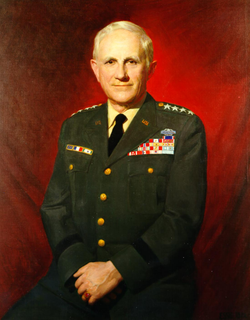Harold K. Johnson
| Harold Keith Johnson | |
|---|---|

Joseph Richards Essig's portrait of General Johnson
|
|
| Nickname(s) | Johnny |
| Born |
February 22, 1912 Bowesmont, North Dakota |
| Died | September 24, 1983 (aged 71) Washington, D.C. |
| Allegiance | United States of America |
| Service/branch |
|
| Years of service | 1933–1968 |
| Rank | General |
| Commands held |
Chief of Staff of the United States Army Commandant of the United States Army Command and General Staff College 8th Cavalry Regiment 3d Battalion, 7th Infantry |
| Battles/wars |
World War II Korean War |
| Awards | |
Harold Keith "Johnny" Johnson (February 22, 1912 – September 24, 1983) was Chief of Staff of the United States Army from 1964 to 1968. Regarded as a premier tactician, Johnson became skeptical that the level of resources given to the Vietnam War, much of which went into 'find, fix, and destroy the big main force units' operations, could deliver victory. Johnson came to believe that the Communist forces held a trump card, because they controlled whether there were engagements with US forces, giving an option to simply avoid battle with US forces if the situation warranted it.
As Johnson saw it, the Communist units would always keep their casualties below what they considered a prohibitive level, and could not be swept away by US firepower. He did, however, acknowledge that the U.S. Commander in Vietnam, General William Westmoreland, had little choice but to engage the enemy's main formations, which had to be prevented from securing base areas where they could concentrate. Johnson was instrumental in altering the focus to a counterinsurgency approach, but was frustrated at the US Congress' refusal to provide the manpower necessary for successful pacification. In his later years Johnson said it had been obvious that US national mobilization was required to win in Vietnam, and he regretted not resigning in protest at the government asking the army to fight a war without hope of ultimate victory.
Harold Keith Johnson was born in Bowesmont, North Dakota on February 22, 1912. After graduation from high school in 1929, Johnson attended the United States Military Academy, West Point, New York. On June 13, 1933, he was commissioned as a second lieutenant in the infantry. Johnson’s first duty assignment was with the 3rd Infantry (Old Guard) at Fort Snelling, Minnesota.
In 1938, Johnson attended Infantry School at Fort Benning. Upon graduation, he was assigned to the 28th Infantry at Fort Niagara, New York. Requesting overseas transfer, Johnson was reassigned to the 57th Infantry (Philippines Scouts) at Fort McKinley, Philippine Islands in 1940. After the Battle of Bataan, Johnson became a prisoner of the Japanese on 9 April 1942. Participating in the Bataan Death March, Johnson was eventually imprisoned at Camp O'Donnell, Cabanatuan and Bilibid Prison. In December 1944, the Japanese attempted to transfer Johnson and 1600 other POWs out of the Philippines. On 14 December 1944, American fighter planes sunk the Japanese ship the Ōryoku Maru killing over 300 of the POWs. Johnson survived and was eventually transferred to Japan. Unwilling to give up their POWs to the advancing Allies, Japan again transferred Johnson. Finally ending up in Korea, Johnson was liberated by the 7th Infantry Division on September 7, 1945.
...
Wikipedia
